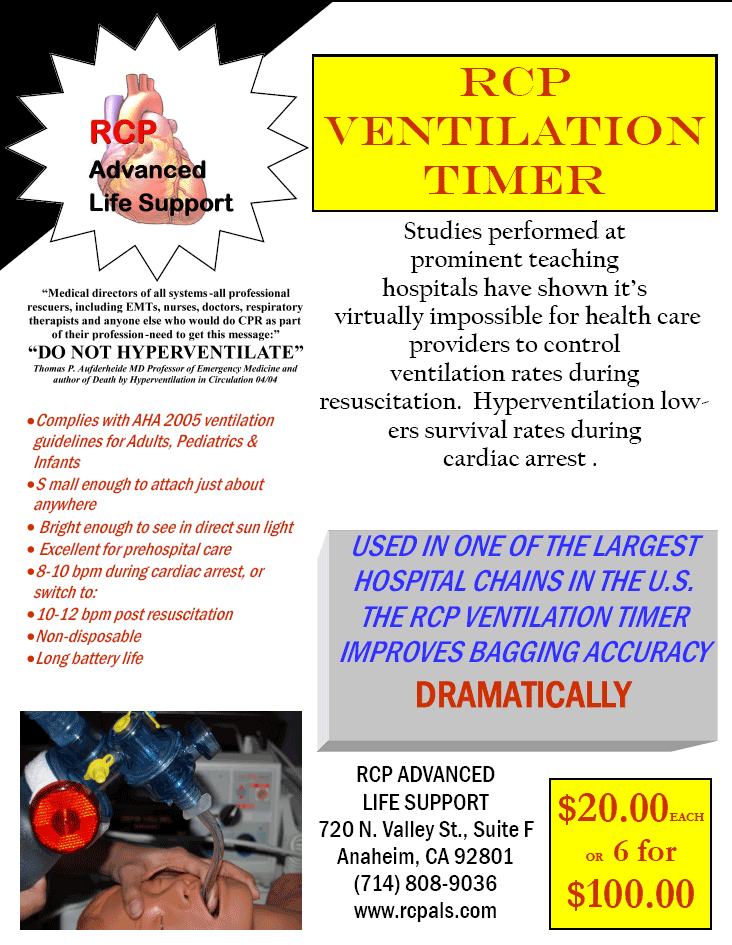A novel ventilation timing device improves accuracy of rescue breathing in simulated cardiac arrest and simulated post resuscitation care.
Jeff Laabs RCP, Ken Burnette EMT-S, Eden Bondoc RCP RRT,
Massimiliano Ciniglio MD
Jeff Laabs RCP, Ken Burnette EMT-S, Eden Bondoc RCP RRT,
Massimiliano Ciniglio MD
Background: Several recent studies have demonstrated that Health Care Providers (HCP) rarely follow published international resuscitation guidelines while performing various aspects of Cardiopulmonary Resuscitation (CPR). Hyperventilation is a common and significant problem.
The purpose of this study was to evaluate the use of a flashing ventilation timing device (RCP Ventilation Timer, RCP Advanced Life Support, Anaheim California. USA) designed to improve ventilation rate accuracy in cardiac arrest and post resuscitation care. This device flashes 8 times per minute during cardiac arrest and can be switched to 12 times per minute for post resuscitation care, the recommended 2005 international guidelines. Methods: We tested 100 healthcare providers of various medical backgrounds (RN, RT, EMT B, paramedics and physicians). All had current certification in basic life support for healthcare providers according the 2005 standards of the American Heart Association (AHA). We instructed all participants to bag the manikins as they had been instructed during their most recent AHA CPR class, or demonstrate how they would bag a real patient in cardiac arrest with an advanced airway and then, post resuscitation with an advanced airway. We used a recording manikin to document participant performance (Resusci-anne skill reporter, Laerdal Corp, Norway) and videotaped all participants to manually verify rate of ventilation. All participants then had a two (2) minute hands on introduction to the RCP Ventilation Timing Device (VTD). All participants were instructed to squeeze the bag every time the VTD flashed and no more or less. All participants then used the VTD to per manufacture recommendations during simulated cardiac arrest and simulated post resuscitation care. Their performance was videotaped and analyzed. We then compared results.
The purpose of this study was to evaluate the use of a flashing ventilation timing device (RCP Ventilation Timer, RCP Advanced Life Support, Anaheim California. USA) designed to improve ventilation rate accuracy in cardiac arrest and post resuscitation care. This device flashes 8 times per minute during cardiac arrest and can be switched to 12 times per minute for post resuscitation care, the recommended 2005 international guidelines. Methods: We tested 100 healthcare providers of various medical backgrounds (RN, RT, EMT B, paramedics and physicians). All had current certification in basic life support for healthcare providers according the 2005 standards of the American Heart Association (AHA). We instructed all participants to bag the manikins as they had been instructed during their most recent AHA CPR class, or demonstrate how they would bag a real patient in cardiac arrest with an advanced airway and then, post resuscitation with an advanced airway. We used a recording manikin to document participant performance (Resusci-anne skill reporter, Laerdal Corp, Norway) and videotaped all participants to manually verify rate of ventilation. All participants then had a two (2) minute hands on introduction to the RCP Ventilation Timing Device (VTD). All participants were instructed to squeeze the bag every time the VTD flashed and no more or less. All participants then used the VTD to per manufacture recommendations during simulated cardiac arrest and simulated post resuscitation care. Their performance was videotaped and analyzed. We then compared results.
Results: All participants initially ventilated faster than the current and previously recommended international resuscitation guidelines without the VTD. Average ventilation rate during simulated cardiac arrest without the VTD was 34 BPM among all participants. Average ventilation rate during simulated post resuscitation care without the VTD was 38 BPM. There were significant differences between professions. All participants had significant improvements while using the VTD. During simulated cardiac arrest, average ventilation rate using the VTD was 9 BPM. During simulated post resuscitation care using the VTD, average ventilation rate was 12 BPM.
Conclusions: This study confirms that healthcare providers routinely hyperventilate patients during simulated cardiac arrest and simulated post resuscitation care. Use of the VTD significantly improved ventilation accuracy and helped providers comply with the 2005 international ACLS ventilation guidelines during simulated cardiac arrest and post resuscitation care. Further studies are needed to clarify to what extent, if any, this will improve survival.
